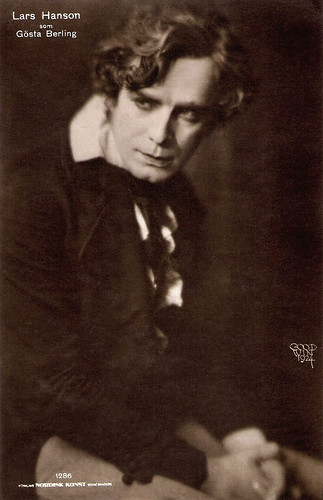
Lars Hanson as Gösta Berling in Gösta Berlings saga (1924). Swedish postcard by Förlag Nordisk Konst, Stockholm, no. 1286. Photo: Goodwin, 1924.
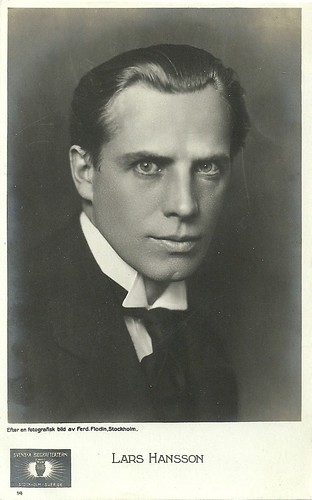
Swedish postcard by Svenska Biografteatern, Stockholm, no. 14. Photo: Ferd. Flodin, Stockholm. Lars Hanson's last name is spelt Hansson on this card.

Swedish postcard by Förlag Nordisk Konst, Stockholm, no. 1097/8. Tora Teje and Lars Hanson in the Swedish silent film Erotikon (Mauritz Stiller, 1920).

French postcard by Cinémagazine-Edition, no. 94. Photo: Gaumont-Metro. Lars Hanson and Greta Garbo in Flesh and the Devil (Clarence Brown, 1926).
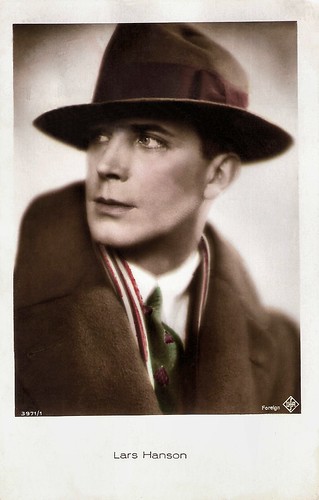
British postcard by Ross Verlag, no. 3971/1, 1928-1929. Photo: Ufa.
Shakespearean Actor
Lars Mauritz Hanson was born in Göteborg, Sweden in 1886. He studied drama in Helsinki, Finland, and at the Dramatens Elevskola in Stockholm. He began his career on the stages of Sweden as a Shakespearean actor, appearing in such classics as Othello and Hamlet. In 1906, he joined the prominent Stockholm Royal Dramatic Theatre.
In 1915, Hanson made his film debut in Dolken/The Dagger (Mauritz Stiller, 1915). He worked again with Stiller on Vingarne/The Wings (Mauritz Stiller, 1916). The story is that of a conniving countess (played by Lili Bech) coming between a sculptor, Claude Zoret (Egil Eide), and his model and suggested lover, Mikaël (Lars Hanson), ultimately leading to Zoret's death in a raging storm at the base of a statue of Mikaël as the mythological Icarus. Vingarne is notable for its innovative use of a framing story and telling the plot primarily through the use of flashbacks.
His popularity as a leading man in his homeland grew with ensuing roles in films like Balettprimadonnan/Anjala the Dancer (Mauritz Stiller, 1916), Therèse (Victor Sjöström, 1917), Tösen från Stormyrtorpet/The Girl From Stormycroft (Victor Sjöström, 1917) and Sången om den eldröda blomman/Song of the Scarlet Flower (Mauritz Stiller, 1919).
A highlight was the sophisticated comedy Erotikon/Seduction (Mauritz Stiller, 1920). The story revolves around an entomology professor (Anders de Wahl) obsessed with the sexual life of bugs, and his easygoing wife (Tora Teje) who is courted by two suitors (Lars Hanson and Vilhelm Bryde). The film became a commercial success in Sweden in 1920 and was sold to 45 markets abroad.
In Synnöva Solbakken/The Girl of Solbakken (John W. Brunius, 1919) and Fiskebyn/The Fishing Village (Mauritz Stiller, 1920), Hanson starred opposite the wife of influential director Gustaf Molander, Karin Molander. They fell in love, and in 1922, Hanson and Molander were married. The couple remained together until Hanson died in 1965.

Swedish postcard by Axel Eliassons Konstförlag, Stockholm, no. 482. 'Gustav III' was a play by August Strindberg and this card refers to one of Hanson's stage play performances, not a film. Hanson played the title role in 1915 (dir. Einar Fröberg) and again in 1928 (dir. Rune Carlsten).

Swedish postcard by Forlag Nordisk Konst, Stockholm, no. 993. Photo: Svenska Biografteatern, Stockholm. Publicity still for Sången om den eldröda blomman/Flame of Life (Mauritz Stiller, 1919).

Swedish postcard by Axel Eliassons Konstforlag, Stockholm, no. 141. Photo: Skandia Film, Stockholm. Lars Hanson and Gull Cronvall in Ett farligt frieri/A Dangerous Proposal (Rune Carlsten 1919). The story deals with Tore, a smallholder's son (Hanson), in love with Aslaug, a farmer's daughter (Cronvall) whose father Knut (Theodor Blich) has ambitious plans to marry her to the son of the wealthiest farmer around. Even after Knut and Aslaug's brothers have beaten Tore black and blue, he persists in visiting Aslaug, even climbing a giant wall of rock...
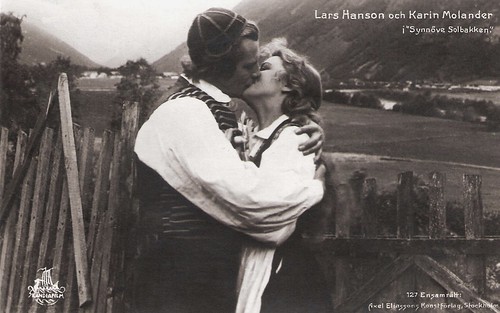
Swedish postcard by Axel Eliassons Konstförlag, Stockholm, no. 127. Photo: Skandiafilm. Still for Synnöva Solbakken/The Girl of Solbakken (1919) with Karin Molander. Sent by mail in Norway in 1920.
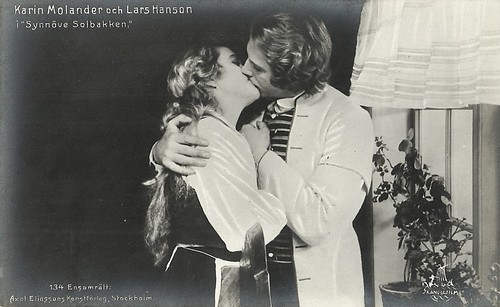
Swedish postcard by Axel Eliassons Konstförlag, Stockholm, no. 134. Photo: Skandia-Film. Publicity still for Synnöve Solbakken (John W. Brunius, 1919), starring Lars Hanson and Karin Molander, and adapted from Bjørnstjerne Bjørnson's novel (1857).
Master of disguise
Lars Hanson was one of the greatest actors in Swedish theatre, starring in plays by William Shakespeare and Eugene O’Neill. He was a master of disguise for his many roles, building his body with implants in his shoes and several layers of clothing, starving himself, and bruising his face with a shoe brush.
While already a well-established popular film actor in Sweden and much of continental Europe, Lars Hanson gained greater international recognition for his role as the title character in Gösta Berlings saga/The Story of Gösta Berling (Mauritz Stiller, 1924).
The film is an adaptation of a book written by the famous Swedish author Selma Lagerlof. It tells the epic story of Gösta, an alcoholic minister who is expelled from the priesthood for his habit, but the bigger problem with his parish is his truthfulness.
Gösta gets a new job in Värmland, a state managed by the people of Ekeby. Gösta's strong personality and his special charm with women bring him many problems. Two powerful families, full of hypocrisy, lies and adultery, rule two estates in Värmland and they surround Gösta with intrigue and problems.
At the end of the film, he gets his redemption at the hands of Elisabeth. This was a role by Greta Garbo in her first major screen appearance.

Swedish postcard by Ed. Axel Eliassons Konstförlag, Stockholm, no. 298. Photo: Skandia Film, Stockholm. Jenny Hasselqvist and Lars Hanson in De landsflyktiga/The Emigrants (Mauritz Stiller, 1921). This is a lost film, except for a few very short fragments.
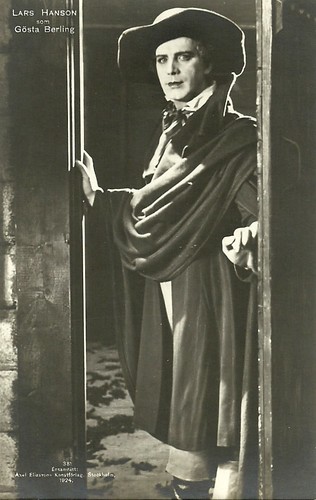
Swedish postcard by Axel Eliassons Konstförlag, Stockholm, no. 381. Lars Hanson as the title character in Gösta Berlings saga/The Saga of Gösta Berling (Mauritz Stiller, 1924).
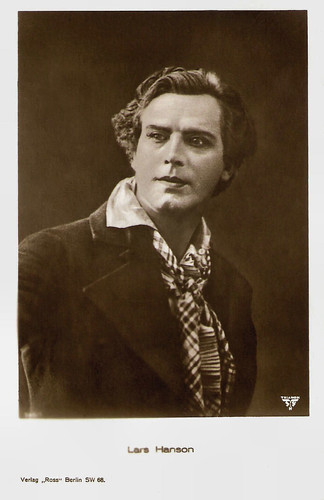
German postcard by Ross Verlag, Berlin. Photo: Trianon.
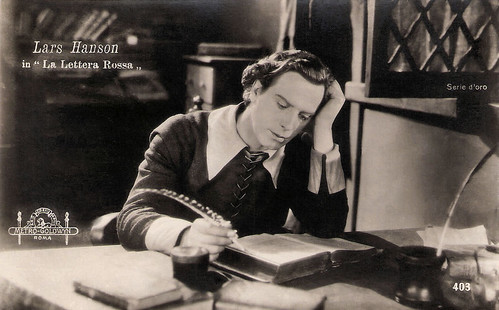
Italian postcard by Ballerini & Fratini, Firenze, no. 403. Photo: Metro-Goldwyn-Mayer, Roma. Lars Hanson as Reverend Arthur Dimmesdale in the MGM period piece The Scarlet Letter (Victor Sjöström, 1926), set in the era of the Puritans.
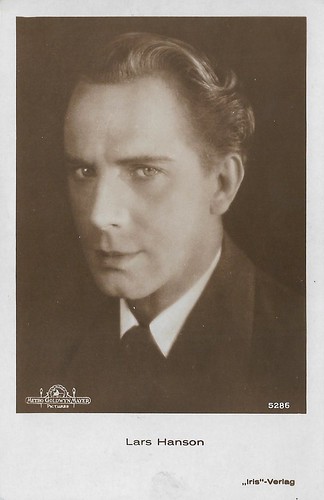
Austrian postcard by Iris Verlag, no. 5286. Photo: Metro-Goldwyn-Mayer.
Liability in American films
At the request of American actress Lillian Gish, Lars Hanson went to Hollywood in 1926 (the same year as Garbo went to the USA) to star opposite Gish in the film version of The Scarlet Letter (Victor Sjöström, 1926). Producer Louis B. Mayer was reluctant on using Gish, fearing opposition from church groups. The film was announced as "It's a real 'A' picture", taking advantage of the 'A' for Adultery. The film made a profit of $296,000.
Next Hanson was paired with Greta Garbo in MGM's box-office hit Flesh and the Devil (Clarence Brown, 1927), which also starred Garbo's offscreen lover John Gilbert, and in The Divine Woman (Victor Sjöström, 1928). The plot of the latter is loosely based on the early life of the French actress Sarah Bernhardt. Sadly, the film is considered lost, only some segments survive.
Sjöström also directed Hanson in a performance opposite Lillian Gish in The Wind (1928), one of the last silent films released by Metro-Goldwyn-Mayer. At its time the film was simultaneously panned and hailed by American critics, and its late release at the dawn of the sound era contributed to a net loss for the production. However, the film had significant critical and considerable commercial success in Europe. The Wind is now considered one of the great masterpieces of the silent era.
Seeing that his heavy Swedish accent might be a liability in American films, Lars Hanson returned to Europe. He starred in the aptly titled German war drama Heimkehr/Homecoming (Joe May, 1928) He co-starred with Gustav Fröhlich as two prisoners of war who are bloodbrothers but then Fröhlich falls in love with Hanson's wife (Dita Parlo).
Hanson continued to appear in Swedish films like the war film Första divisionen/First Division (Hasse Ekman, 1941) and Det brinner en eld/There Burned a Flame (Gustav Molander, 1943). His last performance was in the film Dårskapens hus/The Nuthouse (Hasse Ekman, 1951). Lars Hanson died in Stockholm, Sweden in 1965. He passed away after a short illness at the age of 78.

Austrian postcard by Iris Verlag, no. 5094. Photo: Svenska Film.
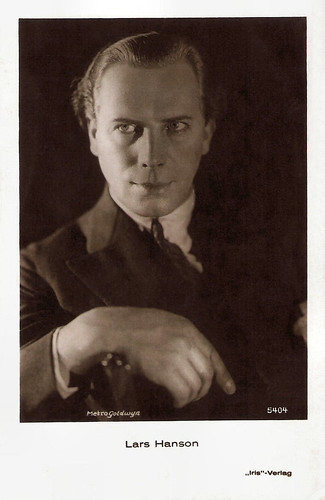
Austrian postcard by Iris-Verlag, no. 5404. Photo: Metro Goldwyn.

German collectors card by Ross Verlag in the series Vom Werden deutscher Filmkunst - Der Stumme Film, picture no. 107, group 43. Photo: Ufa. Dita Parlo and Lars Hanson in Heimkehr/Homecoming (Joe May, 1928).
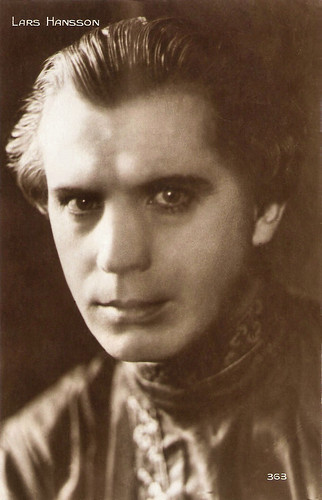
French postcard by Cinémagazine-Edition, no. 363.

German postcard by Ross Verlag, no. 3971/1, 1928-1929. Photo: Ufa.
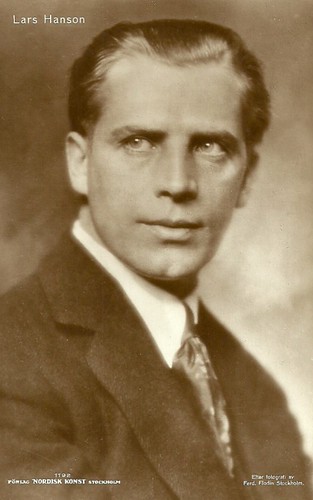
Swedish postcard by Förlag Nordisk Konst, Stockholm, no. 1192. Photo: Ferd. Flodin, Stockholm.
Sources: Wikipedia and IMDb.
This post was last updated on 4 August 2024.
1 comment:
Eccellente sito con le novità del cinema può essere trovata soltanto qui www.cineblog01.bz. Non so che sta parlando d'altro, ma io preferirei essere onesto, non ho visto.
Post a Comment